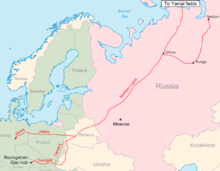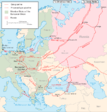- Northern Lights (pipeline)
-
Northern Lights 
Location of Northern LightsLocation Country Russia, Belarus General direction nourth-south-west From Urengoy gas field Passes through Vuktyl, Ukhta, Gryazovets, Torzhok, Smolensk, Minsk Runs alongside Yamal–Europe pipeline General information Type natural gas Operator Gazprom, Beltransgaz Commissioned 1985 Technical information Length 7,377 km (4,584 mi) Maximum discharge 51 billion cubic meters per year Northern Lights (Russian: Сияние северa) is a natural gas pipeline system in Russia and Belarus. It is one of the main pipelines supplying north-western Russia and is an important transit route for Russian gas to Europe.[1]
Contents
History
The Northern Lights pipeline system was built in the Soviet Union from the 1960s to 1980s. Construction of the Vuktyl–Ukhta–Gryazovets–Torzhok section started in 1967 and was completed in 1969. By 1974, the pipeline had been extended to Minsk .[2] The second main trunk line was added during the 1970s and by 1985, a third main trunk line had been built.[3] Originally, gas was supplied by the Vukhtyl gas field, but later the pipeline was extended in order to connect with the Urengoy gas field.
Technical description
The Northern Lights pipeline system has a total length of 7,377 kilometres (4,584 mi), of which around 2,500 kilometres (1,600 mi) is used to transport Russian gas to Europe. The pipeline runs from the Urengoy gas field through Vuktyl, Ukhta, Gryazovets, Torzhok and Smolensk to Minsk in Belarus and from there to Poland, Ukraine and Lithuania.[1][2][4] A part of the newer Yamal–Europe pipeline runs parallel to the Northern Lights pipeline.[1] A branch line from Gryazovets through Saint Petersburg to Vyborg supplies the Saint Petersburg area and Finland. A third parallel line will be added to this branch to supply the Nord Stream pipeline. In Torzhok, the Northern Lights pipeline intersects with the Moscow–Saint Petersburg pipeline suppling the Saint Petersburg area, Latvia and Estonia. The Minsk–Vilnius–Kaliningrad branch line supplies Lithuania and Kaliningrad Oblast while the Ivatsevichy-Dolyna branch line supplies Ukraine and the Kobrin-Brest-Warsaw branch line supplies Poland.
The system from Torzhok to the West consists of five major trunk pipelines:[1][5]
Route Length Strings Capacity Diameter Built in Torzhok-Minsk-Ivatsevichy 454 km 3 45 bcm/year 1200 mm 1975–1983 Ivatsevichy-Dolyna (to Ukraine) 146 km 2 1220 mm 1976/1981 Kobrin-Brest-Warsaw (to Poland) 87 km 1 1020 mm 1985 Minsk-Vilnius (to Kaliningrad and Lithuania) 196 km 1 1220 mm 1988 Torzhok-Dolyna (to Ukraine) 364 km 1 1420 mm 1994 Source:[1] This part of the system has 6 compressors stations. Its technical input capacity is 51 billion cubic meters (bcm) per year; however, due to the age of the pipeline system, its operational capability is estimated to be 46-48 bcm per year. In 2007, it transported 39 bcm of gas; 20.6 bcm to Belarus for domestic supply and 18.4 bcm for transit to Europe. The total amount of Russian gas transmitted through Belarus to Europe was 70.1 bcm in 2007.[1]
Ownership
The Russian section of the pipeline system is a part of the unified gas system of Russia and is owned and operated by Gazprom. The pipeline section on the territory of Belarus became Belarusian property after the dissolution of the Soviet Union, and is now owned and operated by Beltransgaz.[1]
References
- ^ a b c d e f g Yafimava, Katja (2009). "Belarus: the domestic gas market and relations with Russia". In Pirani, Simon. Russian and CIS Gas Markets and their Impact on Europe. Oxford University Press. ISBN 9780199554546.
- ^ a b Dienes, Leslie; Shabad, Theodore (1979). The Soviet energy system: resource use and policies. New York: V.H. WinstonNorthern Lights. p. 86. ISBN 9780470266298.
- ^ International petroleum encyclopedia. 16. New York: PennWell Pub. Co.. 1985. p. 196.
- ^ Dahl, Carol Ann (2004). International energy markets: understanding pricing, policies, and profits. New York: PennWell Books. p. 263. http://books.google.com/books?id=QIB2N861DQIC&pg=PT244. Retrieved 2009-10-24.
- ^ "Belarus Gas Pipelines". East European Gas Analysis. 2009-03-12. http://www.eegas.com/belarus1.htm. Retrieved 2009-10-19.
Pipeline systems of Russia by year of launch Gas pipelines Saratov–Moskva pipeline (1946) • Northern Lights (1975–1994) • Urengoy–Pomary–Uzhgorod pipeline (1983) • Yamal–Europe pipeline (1997) • Blue Stream (2003) • Dzuarikau–Tskhinvali pipeline (2009) • Baku–Novo Filya pipeline (2010) • Bovanenkovo–Ukhta (2011) • Nord Stream (2011–2012) • Sakhalin–Khabarovsk–Vladivostok pipeline (2011–2012) • Central Asia–Center (1960–1988; 2011–2012) • Altai gas pipeline (2011–2013) • South Stream (2015)
Petrol pipelines Grozny–Tuapse oil pipeline (1928) • Tikhoretsk–Tuapse pipeline (1962) • Druzhba pipeline (1964) • Uzen–Atyrau–Samara pipeline (1971) • Baku–Novorossiysk pipeline (1997) • Baltic Pipeline System (2001) • Caspian Pipeline Consortium (2004) • Eastern Siberia – Pacific Ocean oil pipeline (2010) • Baltic Pipeline System-II (2012–2013) • Murmansk Pipeline (date is open)Other pipelines Ammonia: Tolyatti–Odessa pipelineSee also: Water pipeCategories:- Pipeline systems of Russia
- 1985 establishments
- Natural gas pipelines in Europe
- Gazprom pipelines
- Energy in Belarus
- Energy in Russia
- Energy in the Soviet Union
Wikimedia Foundation. 2010.

